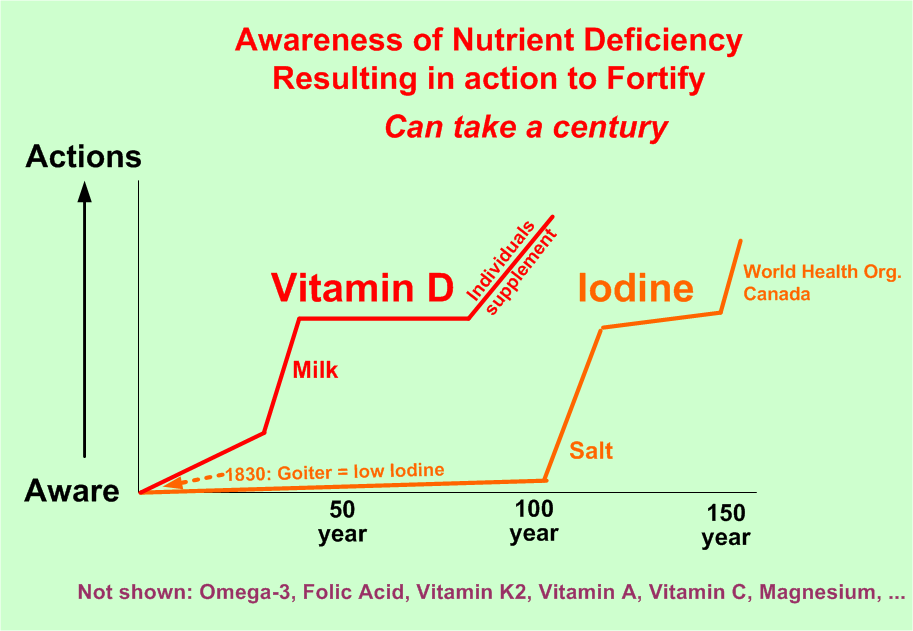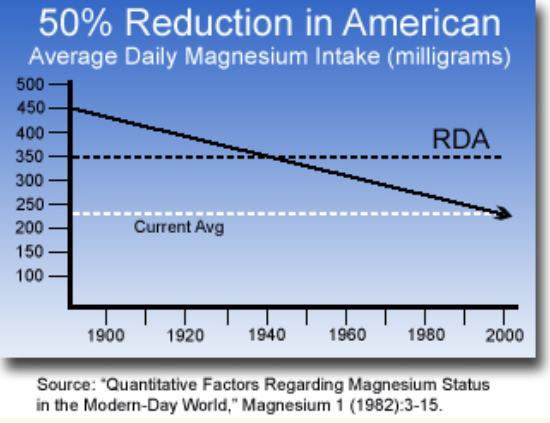Typically takes a century for govts to fortify food with nutrients (like vitamin D)

Phases seem to typically be:
Detect association between nutrient and a health problem
Determine that the lack of the nutrient is a major cause of the health problem
Individuals and companies supplement with the nutrient
Government recommends a minimum daily amount (RDA) of the nutrient
Government sometimes then fortifies food (milk, salt, bread, . . ) with a bare minimum amount of the nutrient
Government increases the amount of fortification a half century later due to one or more of the following
- Decreased use of the food (e.g. milk, salt) - note: Switzerland is the only country to have recently increased the amount of Iodine in salt
- Decrease in other sources of the nutrient (less sunshine ==> less Vitamin D)
- Decrease in cofactors needed with the nutrient (Magnesium)
Unfortunately uniform fortification ends using so little as to only partially help about 20% of the population
Often there is a concern that too much fortification will caused problems with some drugs (increase or decrease potency), or rare health problems
Very difficult to have one-size-fits all for anything: fortification, clothing, seats, shoes, eye glass intensity, size of print, calories, hearing aids, etc.
Vitamin D home fortification- don't wait 100 years for your govt
See also VitaminDWiki
Vitamin D history back to Egyptians and fortification - Aug 2011
Vitamin D can fortify a variety of food and drinks – even beer – March 2012
Thoughts on improving vitamin D policies - Vieth Nov 2013 Iodine example
Saudi have very little vitamin D fortification of food - April 2013
Milk fortification of 1000 IU got most children above 20ng of vitamin D – March 2013
Can fortify food with 1000 IU of vitamin D - Italy, March 2013
A balanced diet is no longer enough – supplements needed - VitaminDWiki Oct 2012
VITAMIN D: Public Shouldn’t Wait For Doctors To Usher In New “Golden Era” Of Preventive Medicine
Germany does not fortify ANY food with vitamin D, is considering 1000 IU from bread – Nov 2013
Incidence of 22 health problems related to vitamin D have doubled in a decade
Vitamin D home fortification- don't wait 100 years for your govt
ODIN: Europeans study vitamin D fortification and testing with some suggestions by VitaminDWiki
43 reasons for Vitamin D deficiency has the following graphic

- Overview Magnesium and vitamin D big decline in past 100 years

See also web
Pellegra and Vitamin B3 (Niacin) Dr. Heaney Nov 2013 - also took a century
Folic Acid History Wikipedia Dec 2013 - clips
- 1920s, scientists believed folate deficiency and anemia were the same condition
- 1930's Folate was identified as the corrective substance in brewer's yeast
- 1948 clinical efficacy was proven by Sidney Farber
- 1960, experts first linked folate deficiency to neural tube defects
- 1990s (late), US scientists implemented the folate fortification program
Vitamin C was the focus of perhaps the first Random Controlled Trial (RCT) in 1758
Is Food Fortification Necessary? An Historical Perspective 2009
- 1921 Clinical Trial of Iodine presented at AMA conference, 1924 Iodized salt was common
Micronutrient Deficiency Conditions: Global Health Issues date unknown PDF at the bottom of this page
Should Foods Be Fortified Even More? Science News Sept 2004
- Currently, the federal government requires that manufacturers enrich cereal-grain products with five nutrients—iron and the vitamins thiamine (B1), riboflavin (B2), niacin (B3), and folate (B9). The total cost to U.S. consumers of adding calcium and vitamin D to the list should be no more than about $19 million a year, Harold L. Newmark of Rutgers University and his colleagues report in the August American Journal of Clinical Nutrition.
- Calcium and Vitamin D would add an estimated 6 to 10 cents to the cost of food per person per year—or collectively some $19 million.
- The team contrasts that amount with the annual savings of averting some 300,000 fractures ($2 billion) and preventing some 27,000 cases of colon cancer (more than $1 billion).
- Food fortification spurred by military purchases 2003
- Flour fortification was greatly boosted in the US when the Army required all their bread be fortified during WWII
